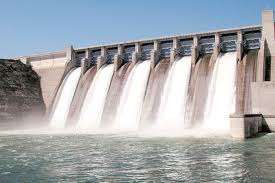ISLAMABAD: In an encouraging development, the government has undertaken 10 important hydro projects to produce 9350 MW cheaper electricity and enhance water storage capacity to resolve power shortage and irrigation water scarcity issue once for all, sources Said.
The listed hydro power projects included Kohala power project, having 1024 MW power generation and 39 thousand acre water storage capacity. The works on Kohala power project is in progress and It will be completed in 2024. Mehmand dam project is next on the list. It will produce 800 MW electricity, besides having 1.3 million acre water storage capacity to substantially enhance the country’s water storage to meet irrigation demand in the future, Diamer Bhasha dam has 4500 MW power production capacity and massive water storage of 6.6 million acre feet . Dasu dam has capacity of producing 420 MW electricity and water storage capacity of 1.5 million acre. Mehmal dam will produce 640 MW electricity, Sokhi hydro power project to produce 884 MW. Mehaj hydro power project to produce 12 MW electricity, Kero project to produce 720 MW power, Balakot hydro power project and Koto hydro power project to produce 320 MW and 40 MW electricity respectively. Most of listed hydro power projects will complete in 2024. These hydro projects require billions of dollars investment and the government is channelising various resources including donors and indigenous resources to meet their expense, A Water and Power Division official said in an informal talk with NEWSMAN.
Pakistan has been blessed with great potential of producing power from water resources, but it failed to capatilise these resources in the past mostly due to unwillingness of the respective governments of the last one and half decades. Pakistan is faced with serious power crisis for years. It resulted in crippling of its economy, besides making the lives of the people miserable who braved hours long load shedding daily. By 2007 things had gone worse as Shaukat Aziz rule did nothing to add electricity despite rising demand in his tenure. Shaukat Aziz rule ended- up with around 4000 MW shortage in the system during peak summer months. Shaukat Aziz rule was followed by PPP regime, which did not bother to resolve serious issues including the power crisis. Its only priority was to make money through commission without doing any work. Next 5 years of PPP regime spiked electricity shortage that forced more than half of industries in the country to shut down and sizable share of the remaining 50 percent to shift from Pakistan to Egypt and Bangladesh. But it was not a worry for PPP government. The PPP rule ended- up with maximum load-shedding in the country in 2013 to daily load-shedding to over 7000 MW during peak summer season. Then came in PMLN in 2013. In its first 3 years of the rule, PMLN preferred to keep playing with the galleries and keep doing politics by holding the PPP responsible of dragging the country in power crisis. This PLMN policy by the time had brought Pakistan down to the knees. Its economy had crippled, industry gone redundant, businesses left with no other option but to switch over to other costly options like diesel generators and UPS usage for survival. In the last two years of the rule, PMLN did took some practical steps to address the issue of load shedding. Here again Its ‘smart’ leadership who knew that in next elections in 2018, the people will not vote for the party if it did not delver to address power shortage went for costlier option of coal and gas-fired projects as it was a short term and costly option, intentionally overlooking the cheaper source of hydro power generation to address the problem once for all. PMLN government opted for coal and gas- fired power projects for two reasons—first, it could be completed before 2018, general elections to get public votes and second, it was an easy option for PMLN leadership to make commission from import and commissioning of obsolete plants .
Pakistan has been a worse victim of international conspiracies. Its cunning enemies inside and outside Pakistan knew that load- shedding was going to make it a country like Rawanda. To implement its agenda, the conspirators, first hired the policy-makers (beaurocracy) as their tool to get changed the power mix from hydro to costly furnace fuel. By early 90, Pakistan’s power mix was 70: 30 % from hydro source and fuel (inclusive coal furnace oil) respectively, which cost it less than 0.10 paisa per unit. With the change of mix in next 10 to 15 years, Pakistan’s power mix reversed and changed to hydro 30 percent and furnace fuel 70 percent. This change of mix, destroyed Pakistan systematically. Its system of power generation over the years succumb to oil mafia and its losers were the consumers who were left with no other option, but to buy costly electricity.
Now after 30 years of mafia’s rule in Pakistan’s power sector, PTI government has taken hydro power potential seriously and launched 10 key projects to add much needed 9360 MW electricity. With coming in of around 10000 MW electricity in the system in next 4 to 7 years, Pakistan’s mix will again change drastically and its benefit will ultimately go to the consumers in the form of cheaper electricity.
The government is fully cognizant of the issues confronting Pakistan on power front and it will take all possible measures to complete listed hydro power project within given framework, the official concluded.
Pakistan going hydro to make cheaper electricity, enhance water storage
Arif Rana is the Chief Editor and senior correspondent, Islamabad based journalist, who did his Master in English Literature from Government College University Lahore.

